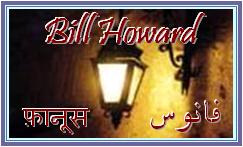
By Bill Howard ‘फ़ानूस’1
—उर्दू ज़बान की चाशनी में घुली महफ़िल-ए-सुख़न—
When one mentions Urdu to a Hindi speaker, it is not uncommon to hear him reply that Urdu is a sweet language. This association with sweetness to the ear stems from the fact that Urdu borrows words from many languages which in turn provides it with a richness of vocabulary, in particular words from Persian and Arabic. This in turn enhances its appeal as a poetic language, especially given the fact that many early Urdu poets studied and composed works in Persian.
Many noted masters of Urdu poetry take pride in utilizing Arabic and Persian words, expressions, and phrases in their compositions. These poets and writers, as do poets and writers in all languages, are proud of their skill with words. In fact, Urdu even has a special word, तग़ज़्ज़ल, to describe this. It connotes a poetic touch. “A poet with such a touch can turn an ordinary thought or observation into a masterpiece of art. Such a poet has an outstanding control on language and a vast repertoire of words and idioms.”2
Aside from pure vocabulary, there are two grammatical constructs taken directly from Persian that are common in Urdu poetry forms such as ghazals. Examples of these constructs are दर्द-ए-दिल and शब-ओ-रोज़, which in normal Urdu or Hindi would be दिल का दर्द and शब और रोज़. In addition to the grammatical form, it is common for these constructs to use words of Arabic or Persian origin, some of which are very literary or obscure to someone who has not made a specific study of Urdu poetry.
These structures in themselves create a poetic effect because of their contrast to the standard Urdu or Hindi constructs. They tend to focus the eye or the ear on the particular turn of phrase, thus giving it an emphasis that it might not otherwise have. Beyond this, however, these constructs tend to become the poet’s tools. They allow the shaayar a freedom to play with his language.
Firstly, they give the shaayar an option to comply with the requirements of metrics (बहर) by using these forms in place of the normal Urdu constructs. Secondly, since these constructs usually consist of Arabic or Persian words, it is easier for the shaayar to play with style and vocabulary. A shaayar may simply be pedantic and want to show his knowledge of obscure words. On the other hand, he may need to substitute a more common word of one or two syllables with one of three or more syllables, or vice versa, in order to structure a misraa that meets the requirements of the poem’s bahar. A शायर, for example, may have to become a सुख़नवर (poet).
The shaayar may also be using his language and these constructs to poetically describe an object or a person rather than relying on the literal meaning of the phrase. Examples of this would be जान-ए-हयात or जान-ए-महबूबी [जान = life, spirit, beloved हयात = life महबूबी = loveliness, love, affection] for “beloved,” which is in a way a play on words given the various meanings of जान and its link to हयात and महबूबी. Another example is तेग़-ए-निगाह [तेग़ = sword निगाह = glance] for a cutting or piercing look.
Linked phrases of the type शब-ओ-रोज़ provide the shaayar with many options. These phrases frequently are used for joining linked pairs of words that are opposites, such as: शब-ओ-रोज़ [night and day] or फ़र्दा-ओ-दी [yesterday and tomorrow]. Shaayars may also combine word pairs that rhyme such as फ़र्श-ओ-अर्श [floor and roof], used in the sher to mean earth and sky, or रहीम-ओ-करीम [merciful and generous]. They may also play with words in different ways such as in this “reverse rhyme”: हमपेशा–ओ-हममशरब–ओ-हमराज़ [the same profession, the same sect, and the same secret]. Note that in this example, मशरब can also be a drinking place. Perhaps the shaayar’s intent is to create a double meaning leaving it up to us to decide. This attests to the तग़ज़्ज़ल of the shaayar.
It is also common for the shaayar to link pairs of words that are almost synonymous to create a sense of emphasis. For example, फ़र्याद-ओ-फ़ुग़ां [फ़र्याद = complaint, cry for help फ़ुग़ां = lamentation, complaint, cry of pain], प्याला-ओ-साग़र [cup and goblet], रंज-ओ-मुसीबत [grief and misfortune].
The shaayar is also not restricted to just linking pairs of words. As in the example above, हमपेशा–ओ-हममशरब–ओ-हमराज़, the shaayar has linked three words. Skilled shaayars may sting words together in many combinations like pearls on a necklace as the following examples demonstrate:
- लाल-ओ-ज़ुमुर्रुद - ओ - ज़र-ओ-गौहर हूँ मैं
- शौक़ हर रंग रक़ीब - ए - सर - ओ - सामाँ निकला
- फ़िर देखिये अन्दाज़ - ए - गुल - अफ़्शानि - ए - गुफ़्तार
- वाँ वो ग़ुरुर - ए - इज़ा’ज़ - ओ - नाज़ याँ ये हिजाब - ए - पास - एवज़’आ
हर एक लफ़्ज़ (शब्द) मोती होता है! हर एक शेर हार होता है! हर एक ग़ज़ल संदूक़-ए-ज़ेवर होती है! उर्दू ज़रूर मीठी ज़बान होती है लेकिन मिर्ज़ा दाग़ देहलवी इस शेर में हम को याद दिलातो हैं कि :
नहीं खेल, अए दाग़! यारों से कह दो
कह आती है उर्दू ज़बान आते आते
“फिरे राह से वह यहां आते आते”
[मिर्ज़ा दाग़ देहलवी]
نہيں کھيل ، اے داغ! ياروں سے کہ دو
کہ آتي ہے اردو زباں آتے آتے
پھرے راہ سے وہ يہاں آتے آتے
(مرزا داغ دہلوي)
1 I have realized that my Central Asian alter ego desired a तख़ल्लुस. I have chosen ‘फ़ानूस’.
2 “taKhayyul and taGhazzul : The Soul of Urdu Poetry,” Ifran ‘Abid’, July 2002, http://www.ebazm.com/abid2.htm.
